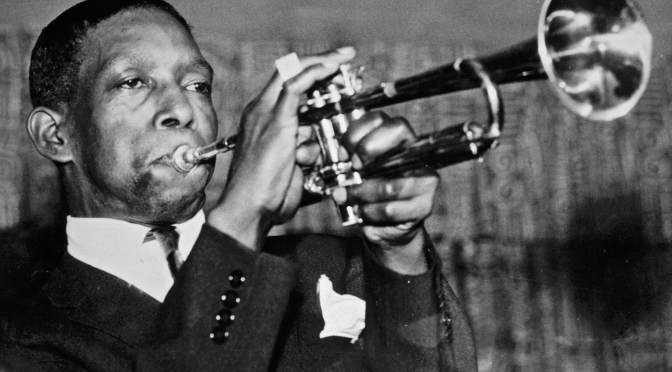Yesterday marked an important day in the discography and music of Kenny Dorham: the first session off his iconic second album, Afro-Cuban.
KD’s first album as leader was called the Kenny Dorham Quintet. Originally released on the Debut label, it was recorded on December 15, 1953 with brothers Jimmy and Percy Heath on tenor/alto sax and bass respectively, Walter Bishop Jr. on piano, and Kenny Clarke on drums. The album Afro-Cuban had a less traditional configuration: it is comprised of two different recording sessions with two different bands entirely.
With the 59th anniversary of this session from the album having just passed, there’s no better time to explore some of the lesser-known facts about the album. The first group of personnel for the January 30th session included Hank Mobley on tenor saxophone, Cecil McKenzie Payne on baritone saxophone, Horace Silver on piano, Art Blakey on drums, and Percy Heath on bass. Mobley, Silver and Blakey were the common denominators with which KD performed regularly between 1954 and 1955. In fact, KD was still a member in good standing with Art Blakey and Jazz Messengers during the January 30th and March 29th sessions – the last known recording Kenny did with the Messengers was the Live at the Cafe Bohemia Volume 3 recorded on November 23, 1955.
The three tunes that were recorded on the January 30th date is as follows: “Venita’s Dance,” “K. D.’s Motion,” and “La Villa.” According to the “Commentary on the Tunes” section by Michael Cuscuna from The Other Side of the Blue Note 1500 Series, a Blue Note Japan release from the early 1980s, the above tunes were supposed to be released on a 10” disc. The operative word here is “supposed.” It is unknown why these three tunes were never released on a 10” disc, while the latin-infused tunes “Minor’s Holiday,” “Lotus Flower,” “Afrodisia” and “Basheer’s Dream” were released on a 10” disc the very year: 1955. Additionally, a fourth tune has emerged from the ether from the January 30th date which was released on The Other Side of the Blue Note 1500 Series 3-LP set and several cds with release dates ranging from 1987 to 2012 according to “www.discogs.com.” This fourth tune, a KD original composition, has some controversy over its title. The title that was used on the Blue Note Japanese release and thereafter was “K. D.’s Cab Ride.” Prior to the Japanese release, the composition had no name according to Michael Cuscuna. Unbeknownst to Cuscuna, KD already assigned a name to the tune which was “Echoes of Spring.” Interestingly, Cuscuna was the mastermind in coming up with “new” name “K. D.’s Cab Ride” from conferring with Hank Mobley that “it was a Kenny Dorham composition and was the sort of tune he [Kenny Dorham] might write in the cab on the way to a record date.” This addendum by Cuscuna can be found in the notes of every issuance since the Japanese release. The quotation from Cuscuna can be found in the notes of the 1987 Blue Note CDP 7-46815-2 release.
Switching gears to actually discuss the music itself, The Penguin Jazz Guide: The History of the Music in 1,001 Best Albums by Brian Morton and Richard Cook points out that Dorham was “self-evidently a Dizzy disciple, particularly as on Afro-Cuban where there are extra beats and half-beats to the measure.” Those instances would most likely be prevalent in the four latin-flavored tunes due the already established relationship Dizzy had with Afro-Cuban and latin rhythms via percussionists such as Machito, Chano Pozo, Mongo Santmaria, and Carlos “Patato” Valdes just to name a few. (A more comprehensive look into the Afro-Cuban side of the album will be in part two of this posting.) Morton and Cook go on to say that even though Dorham was a pupil of Gillespie, “…Dorham had a nice rounded tone and even attack which make him more distinctive than is usually thought.” Here is a concise survey of the four compositions from the the first session: “Venita’s Dance” has an almost melancholy theme and to supplement that feeling is KD’s solo, consisting mainly of descending lines. Just as everything must come to an end, the pastoral mood is then thwarted by Mobley’s distinct attack in relation to his timbre and style. The solos by Silver and Payne also followed suit. “La Villa,” a Dorham original composition, had the promises of traversing genres to become a pop hit according to Leonard Feather in the liner notes for the 1957 Afro-Cuban lp. Although Feather’s high hopes were made in the late-1950s, the probability of a bop tune to jump genres and simultaneously grab the hearts of the general public would have been slim to nil due the advent of new musics like rock and roll. Consequently, the tempo would have another issue to contend with, for the fast tempo was ideal for KD’s and the other winds’ solos with the ever-energetic Silver comping behind them. An amazing musical display occurs between KD and Blakey when they trade fours for twenty-four measures before the out-chorus. “K. D.’s Motion” is a burning blues where KD takes four choruses to display his prowess for the idiom. Not only KD shine in his solo, Payne, Mobley and Silver also exhibit superb solos in the blues tradition.
Looking back now, the tunes from the January 30th session are all quintessential Blakey and the Jazz Messengers charts with the addition of Cecil Payne, of course. Payne is an added gem to this already smoking coterie! With the blazing and swing drums of Blakey, bluesy interpretations of Mobley, funky stylings of Horace Silver, and the rhythmically driven bass of Percy Heath, there is no denying that KD and the Messengers have stamped their mark in jazz history.


